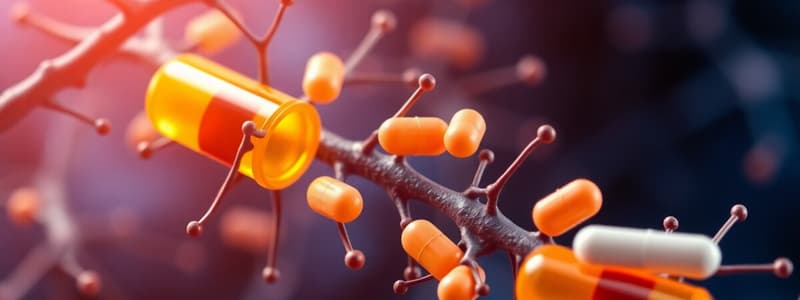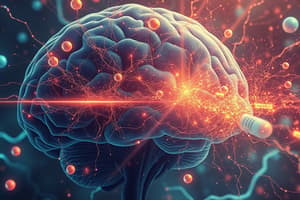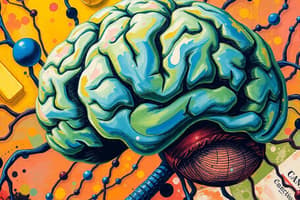Podcast
Questions and Answers
Which area of the brain is primarily responsible for coordinating fine motor control and movement?
Which area of the brain is primarily responsible for coordinating fine motor control and movement?
- Cortex
- Brainstem (medulla)
- Midbrain
- Cerebellum (correct)
What is the primary mechanism by which neurotransmitters propagate a signal to the next neuron?
What is the primary mechanism by which neurotransmitters propagate a signal to the next neuron?
- Causing electrical depolarization (correct)
- Inhibiting receptor binding
- Causing electrical hyperpolarization
- Blocking transport proteins
What is the typical fate of neurotransmitters after they have been released and used in neuron-to-neuron communication?
What is the typical fate of neurotransmitters after they have been released and used in neuron-to-neuron communication?
- They are excreted from the body via the bloodstream.
- They are permanently deactivated by enzymes in the synapse.
- They are broken down into component parts and eliminated
- They are returned to the releasing nerve terminal and recycled. (correct)
Which of the following factors does not influence the effect of neurotransmitters?
Which of the following factors does not influence the effect of neurotransmitters?
What is the primary mechanism of action for selective serotonin reuptake inhibitors (SSRIs) in treating depression?
What is the primary mechanism of action for selective serotonin reuptake inhibitors (SSRIs) in treating depression?
Which condition are mood stabilizers primarily used to treat?
Which condition are mood stabilizers primarily used to treat?
Which of the following is a common potential side effect of lithium, a mood stabilizer?
Which of the following is a common potential side effect of lithium, a mood stabilizer?
Which of the following best describes the primary effect of antipsychotic medications on dopamine levels in the brain?
Which of the following best describes the primary effect of antipsychotic medications on dopamine levels in the brain?
How do cholinesterase inhibitors work to manage symptoms of Alzheimer's dementia?
How do cholinesterase inhibitors work to manage symptoms of Alzheimer's dementia?
Which of the following is a common side effect associated with cholinesterase inhibitors used to treat Alzheimer's dementia?
Which of the following is a common side effect associated with cholinesterase inhibitors used to treat Alzheimer's dementia?
What is the primary mechanism by which benzodiazepines reduce anxiety?
What is the primary mechanism by which benzodiazepines reduce anxiety?
Flumazenil is a specific antagonist for which class of anxiolytic drugs?
Flumazenil is a specific antagonist for which class of anxiolytic drugs?
Why are barbiturates generally considered to have a higher risk profile compared to benzodiazepines?
Why are barbiturates generally considered to have a higher risk profile compared to benzodiazepines?
Which of the following is a potential effect of excessive ethyl alcohol consumption?
Which of the following is a potential effect of excessive ethyl alcohol consumption?
What term describes the CNS hyperactivity, sometimes associated with withdrawal from ethyl alcohol?
What term describes the CNS hyperactivity, sometimes associated with withdrawal from ethyl alcohol?
What is one of the main mechanisms by which nonsteroidal anti-inflammatory drugs (NSAIDs) reduce pain?
What is one of the main mechanisms by which nonsteroidal anti-inflammatory drugs (NSAIDs) reduce pain?
Aspirin, a common salicylate, is associated with an increased risk of Reye's syndrome in which population?
Aspirin, a common salicylate, is associated with an increased risk of Reye's syndrome in which population?
What is a significant risk associated with acetaminophen (Tylenol) overdose?
What is a significant risk associated with acetaminophen (Tylenol) overdose?
Strong opioids are known for which of the following characteristics?
Strong opioids are known for which of the following characteristics?
What is a common side effect associated with opioid analgesics?
What is a common side effect associated with opioid analgesics?
What is the advantage of patient-controlled analgesia (PCA) pumps for opioid administration?
What is the advantage of patient-controlled analgesia (PCA) pumps for opioid administration?
How do local anesthetics primarily function to reduce pain?
How do local anesthetics primarily function to reduce pain?
What is a potential benefit of using epidural analgesia with local anesthetics and/or opioids?
What is a potential benefit of using epidural analgesia with local anesthetics and/or opioids?
What is a potential disadvantage of combining NSAIDs and opioids for pain management?
What is a potential disadvantage of combining NSAIDs and opioids for pain management?
What is a characteristic symptom associated with neuropathic pain?
What is a characteristic symptom associated with neuropathic pain?
How is the depth of anesthesia typically determined during a medical procedure?
How is the depth of anesthesia typically determined during a medical procedure?
What is the primary goal of conscious sedation during a medical procedure?
What is the primary goal of conscious sedation during a medical procedure?
What is a key requirement for providing conscious sedation?
What is a key requirement for providing conscious sedation?
What is the main therapeutic use of analeptic drugs?
What is the main therapeutic use of analeptic drugs?
Which of the following areas is the cortex associated with?
Which of the following areas is the cortex associated with?
Which of the following is a function of the Brainstem (medulla)?
Which of the following is a function of the Brainstem (medulla)?
Which of the following is a function of the Midbrain?
Which of the following is a function of the Midbrain?
Which of the following can be a result of high enough doses of Opioid Analgesics?
Which of the following can be a result of high enough doses of Opioid Analgesics?
Which of the following is NOT used primarily for bipolar disorder?
Which of the following is NOT used primarily for bipolar disorder?
Which of the following is NOT an older agent of Antipsychotics?
Which of the following is NOT an older agent of Antipsychotics?
Which of the following is NOT a drug for Alzheimer's Dementia?
Which of the following is NOT a drug for Alzheimer's Dementia?
Which of the following is NOT true of the routes of opioid administration?
Which of the following is NOT true of the routes of opioid administration?
Flashcards
Drugs Affecting the CNS
Drugs Affecting the CNS
Drugs that affect the central nervous system, used therapeutically and recreationally.
Cortex
Cortex
The location of thought,memory, self-awareness, personality, and speech
Midbrain
Midbrain
Relay station for cortex, hypothalamus
Brainstem (medulla)
Brainstem (medulla)
Signup and view all the flashcards
Cerebellum
Cerebellum
Signup and view all the flashcards
Neurotransmitters
Neurotransmitters
Signup and view all the flashcards
Neurotransmitter reuptake
Neurotransmitter reuptake
Signup and view all the flashcards
SSRIs
SSRIs
Signup and view all the flashcards
Mood stabilizers
Mood stabilizers
Signup and view all the flashcards
Antipsychotics
Antipsychotics
Signup and view all the flashcards
Cholinesterase inhibitors
Cholinesterase inhibitors
Signup and view all the flashcards
Anxiolytics
Anxiolytics
Signup and view all the flashcards
Barbiturates
Barbiturates
Signup and view all the flashcards
Other Hypnotics
Other Hypnotics
Signup and view all the flashcards
Ethyl Alcohol
Ethyl Alcohol
Signup and view all the flashcards
Delirium Tremens
Delirium Tremens
Signup and view all the flashcards
Pain
Pain
Signup and view all the flashcards
NSAIDs Mechanism
NSAIDs Mechanism
Signup and view all the flashcards
Opioid Analgesics
Opioid Analgesics
Signup and view all the flashcards
Opioid Side Effects
Opioid Side Effects
Signup and view all the flashcards
Local Anesthetics
Local Anesthetics
Signup and view all the flashcards
Epidural Analgesia
Epidural Analgesia
Signup and view all the flashcards
Anesthesia
Anesthesia
Signup and view all the flashcards
Conscious Sedation
Conscious Sedation
Signup and view all the flashcards
Analeptic drugs
Analeptic drugs
Signup and view all the flashcards
Study Notes
Drugs Affecting the Central Nervous System (CNS)
- The drugs that affect the CNS are the most widely used drugs both therapeutically and recreationally.
- The cortex of the brain is responsible for thought, memory, self-awareness, personality, and speech.
- The midbrain serves as a relay station for the cortex and hypothalamus.
- The brainstem (medulla) controls areas for autonomic functions.
- The cerebellum is responsible for fine motor control, and coordinates movement.
Neurotransmitters
- Neurotransmitters cause electrical depolarization and passage of signal to the next neuron.
- Most neurotransmitters are returned to releasing nerve terminal and recycled.
Neuron-to-Neuron Communication
- Neurotransmitters are synthesized in the nerve, then transported and stored in the nerve terminal.
- Transport proteins (TP) present in the synapse are components of neurotransmission.
- Receptors (R) are present on both, the postjunctional and prejunctional membranes.
- Membrane-bound enzymes (ENZ) along with modifying neurons are components of neurotransmission.
Neurotransmitter Pathway
- After axonal depolarization, stored neurotransmitter (NT) is released into the synapse.
- NT binds to transport or carrier protein (TP) in the synapse, is transported to and binds with postjunctional receptors (2).
- NT is metabolized by membrane-bound enzymes (2), actively taken up by the releasing neuron (3), or is released and binds to prejunctional receptors.
- NT substance that is degraded to its component parts is taken up by the releasing neuron to be resynthesized and reused (4).
Factors Impacting Neurotransmitter Effect
- Amount of neurotransmitter released
- Type and quantity of transport proteins
- Previous neurotransmitter release
- Presence of modifiers
- Efficiency of reuptake process
- Activities of modulating interneurons
Psychiatric Medications - Antidepressants
- Selective serotonin reuptake inhibitors (SSRIs) are considered first-line treatment for depression.
- Serotonin norepinephrine reuptake inhibitors are a newer option for treating depression.
Mood Stabilizers
- Mood stabilizers are primarily used for bipolar disorder, which involves alternating depression and mania (or hypomania).
- Examples of mood-stabilizing drugs are: lithium, valproic acid, carbamazepine, gabapentin, lamotrigine, and antipsychotics.
- Sedation is the main side effect of mood stabilizers, except for lithium.
- Lithium can cause tremors, cognitive slowing, hypothyroid, renal insufficiency, leukocytosis, polyuria, and polydipsia
- Lithium has a narrow therapeutic window and can cause coma.
Antipsychotics
- Antipsychotics work by increasing dopamine levels in the brain.
- They are used to treat psychotic disorders, including:
- Impaired reality
- Schizophrenia
- Psychosis associated with depression or mania
- Older antipsychotic agents have numerous side effects.
- Thorazine
- Thioridazine
- Haloperidol
- Newer antipsychotic agents are more tolerable.
- Risperidone
- Olanzapine
- Quetiapine
Drugs for Alzheimer's Dementia
- Cholinesterase inhibitors increase acetylcholine levels in the brain
- Donepezil
- Tacrine
- Galantamine
- Rivastigmine
- Cholinesterase inhibitors may cause gastrointestinal (GI) side effects.
Anxiolytics
- Used to reduce anxiety
- Also used as amnestics
- May augment opioid respiratory depression
- Benzodiazepines
- Hyperpolarize neurons
- Good for anesthesia induction
- Prevent "unpleasant recall"
- Terminate seizures/increase threshold
- Promote sleep
- Specific antagonist: flumazenil
Barbiturates
- Have toxic potential and rapid tolerance
- Depress neuron activity
- High risk of addiction and abuse
- Used for:
- Anesthesia induction: thiopental, thiamylal, methohexital
- Hypnotics: pentobarbital, secobarbital
- Seizures: phenobarbital
Barbiturates: Mode of Action
- Barbiturates and benzodiazepines (BDZ) depress CNS function.
- Stimulation of receptors on the chloride ion channel facilitates γ-aminobutyric acid (GABA)–induced inhibition of neuronal function.
Other Hypnotics
- Often used to induce sleep
- Hypnotics to induce sleep are generally recommended for 1–2 weeks
- Eszopiclone:
- New drug
- Approved for long-term use
Ethyl Alcohol
- A socially acceptable, nonprescription sedative-hypnotic.
- Also has a disinhibiting effect.
- In excess, it acts as a general anesthetic.
- At 400 to 600 mg/dl, it can cause respiratory arrest.
- Delirium tremens results in CNS hyperactivity on withdrawal.
Pain Treatment
- Pain is now considered the fifth vital sign.
- Visual or numerical analogy pain scales assess pain.
- Pain is subjective, unpleasant, and difficult to quantify objectively.
- Pain experience:
- Pain: Input from CNS pain receptors Suffering: Emotional response to pain experience
Nonsteroidal Antiinflammatory Drugs (NSAIDs)
- Affect the hypothalamus and inhibit the production of inflammatory mediators at the pain site.
- May cause gastric irritation/ulceration.
- Salicylates are the oldest, aspirin.
- Increased incidence of Reye’s syndrome in children.
- Acetaminophen (Tylenol):
- Effective on mild/moderate pain
- No antiinflammatory effects
- May cause lethal hepatic necrosis
- No negative GI effects
- COX-2 inhibitors are being reevaluated.
Opioid Analgesics
- Derivatives of naturally occurring opium
- Used to treat moderate to severe pain
- Exert effect by binding to receptors for endogenous opioids (endorphins and enkephalins)
- High enough doses result in loss of consciousness, respiratory arrest
- Popular drugs of abuse
- Euphoric effect
- May cause LOC & respiratory arrest
- Strong opioids are narcotics
Opioid Analgesics Side Effects
- Respiratory depression
- Constipation
- Nausea
- Vomiting
- Antitussive effects
Routes of Opioid Administration
- As needed (by nurse)
- Patient-controlled analgesia (PCA) pumps
- Better to keep control of pain than regain control
- Opioid inhalation
- Decreases dyspnea in advanced respiratory failure
- Showed good clinical effect on cancer patients without lung disease
- No studies show improved effectiveness when inhaled
Local Anesthetics
- Interrupt nerve signals (pain) from damaged area
- Block Na+ channels along nerve cells
- Also useful as analgesia and for terminating cardiac conduction abnormalities
- Can suppress irritant tracheal cough response
Chemical Structures of Local Anesthetics
- Chemical structures of local anesthetics procaine and lidocaine, showing their respective ester and amide linkages, location of the lipophilic group, and ionizable amine group.
Epidural Analgesia
- Infusions of local anesthetics/opioids improve postoperative pain therapy and outcome.
- Provides better pain control versus systemic analgesics.
Combinations of Analgesic Classes
- Prescription combinations of NSAIDs & opioids are widely available
- Separate dosing may prove better with various side effects, toxicities, and half-lives
- More troublesome for patients to take independently
Chronic Pain Syndromes
- Central sensitization can occur secondary to acute pain from surgery or trauma
- Hyperesthesia, hyperpathia, and allodynia
- Treatment during acute phase may reduce likelihood of neuropathic problems later
Characteristics of Neuropathic Pain
- Evidence of primary injury
- Pain involving body area with sensory loss
- Pain characterized as burning, electric or shooting
- Dysesthesias in the area
- Sympathetic hyperactivity
- Hyperalgesia, hyperpathia, and allodynia
Anesthesia
- Drug-induced absence of perception
- Usually inhaled or IV
- Gases and volatile liquids
- Depth determined by response to painful stimuli
- Change in heart rate or blood pressure
Anesthesia (cont’d)
- Pharmacological modification of painful and frightening experiences during medical procedures
- Patient remains conscious
- Able to communicate and protect airway
- Ability may be lost during procedure
Conscious Sedation
- Goal is improved patient comfort and outcome
- Conscious sedation standards are required by The Joint Commission (TJC)
Providing Conscious Sedation
- Resuscitation equipment and trained personnel immediately available
- Conscious sedation requires more than one person
- Deep sedation/general anesthesia requires at least three people
- Progression from conscious sedation to deep sedation to general anesthesia may be difficult to control
- One person solely monitors vital signs
CNS and Respiratory Stimulants
- Analeptic drugs increase activity of the brain
- Used to treat narcolepsy, attention-deficit hyperactivity disorder (ADHD), obesity
- No clinical role in treating respiratory failure
Studying That Suits You
Use AI to generate personalized quizzes and flashcards to suit your learning preferences.



